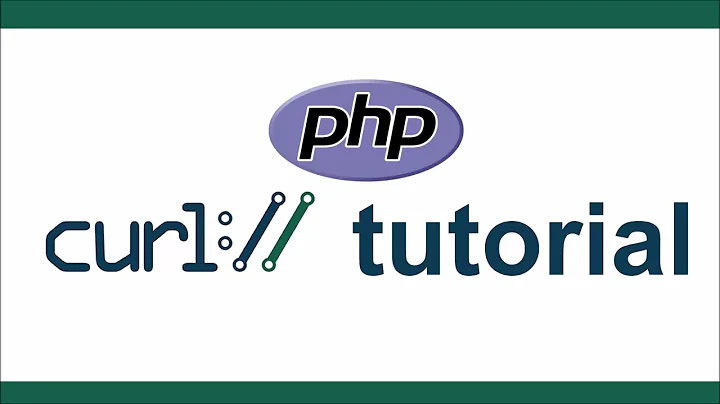PHP CURL DELETE request
156,991
Solution 1
I finally solved this myself. If anyone else is having this problem, here is my solution:
I created a new method:
public function curl_del($path)
{
$url = $this->__url.$path;
$ch = curl_init();
curl_setopt($ch, CURLOPT_URL, $url);
curl_setopt($ch, CURLOPT_CUSTOMREQUEST, "DELETE");
$result = curl_exec($ch);
$httpCode = curl_getinfo($ch, CURLINFO_HTTP_CODE);
curl_close($ch);
return $result;
}
Update 2
Since this seems to help some people, here is my final curl DELETE method, which returns the HTTP response in JSON decoded object:
/**
* @desc Do a DELETE request with cURL
*
* @param string $path path that goes after the URL fx. "/user/login"
* @param array $json If you need to send some json with your request.
* For me delete requests are always blank
* @return Obj $result HTTP response from REST interface in JSON decoded.
*/
public function curl_del($path, $json = '')
{
$url = $this->__url.$path;
$ch = curl_init();
curl_setopt($ch, CURLOPT_URL, $url);
curl_setopt($ch, CURLOPT_CUSTOMREQUEST, "DELETE");
curl_setopt($ch, CURLOPT_POSTFIELDS, $json);
curl_setopt($ch, CURLOPT_RETURNTRANSFER, true);
$result = curl_exec($ch);
$result = json_decode($result);
curl_close($ch);
return $result;
}
Solution 2
To call GET,POST,DELETE,PUT All kind of request, i have created one common function
function CallAPI($method, $api, $data) {
$url = "http://localhost:82/slimdemo/RESTAPI/" . $api;
$curl = curl_init($url);
curl_setopt($curl, CURLOPT_RETURNTRANSFER, true);
switch ($method) {
case "GET":
curl_setopt($curl, CURLOPT_POSTFIELDS, json_encode($data));
curl_setopt($curl, CURLOPT_CUSTOMREQUEST, "GET");
break;
case "POST":
curl_setopt($curl, CURLOPT_POSTFIELDS, json_encode($data));
curl_setopt($curl, CURLOPT_CUSTOMREQUEST, "POST");
break;
case "PUT":
curl_setopt($curl, CURLOPT_POSTFIELDS, json_encode($data));
curl_setopt($curl, CURLOPT_CUSTOMREQUEST, "PUT");
break;
case "DELETE":
curl_setopt($curl, CURLOPT_CUSTOMREQUEST, "DELETE");
curl_setopt($curl, CURLOPT_POSTFIELDS, json_encode($data));
break;
}
$response = curl_exec($curl);
$data = json_decode($response);
/* Check for 404 (file not found). */
$httpCode = curl_getinfo($curl, CURLINFO_HTTP_CODE);
// Check the HTTP Status code
switch ($httpCode) {
case 200:
$error_status = "200: Success";
return ($data);
break;
case 404:
$error_status = "404: API Not found";
break;
case 500:
$error_status = "500: servers replied with an error.";
break;
case 502:
$error_status = "502: servers may be down or being upgraded. Hopefully they'll be OK soon!";
break;
case 503:
$error_status = "503: service unavailable. Hopefully they'll be OK soon!";
break;
default:
$error_status = "Undocumented error: " . $httpCode . " : " . curl_error($curl);
break;
}
curl_close($curl);
echo $error_status;
die;
}
CALL Delete Method
$data = array('id'=>$_GET['did']);
$result = CallAPI('DELETE', "DeleteCategory", $data);
CALL Post Method
$data = array('title'=>$_POST['txtcategory'],'description'=>$_POST['txtdesc']);
$result = CallAPI('POST', "InsertCategory", $data);
CALL Get Method
$data = array('id'=>$_GET['eid']);
$result = CallAPI('GET', "GetCategoryById", $data);
CALL Put Method
$data = array('id'=>$_REQUEST['eid'],'title'=>$_REQUEST['txtcategory'],'description'=>$_REQUEST['txtdesc']);
$result = CallAPI('POST', "UpdateCategory", $data);
Related videos on Youtube
Comments
-
 Bolli over 2 years
Bolli over 2 yearsI'm trying to do a DELETE http request using PHP and cURL.
I have read how to do it many places, but nothing seems to work for me.
This is how I do it:
public function curl_req($path,$json,$req) { $ch = curl_init($this->__url.$path); $data = json_encode($json); curl_setopt($ch, CURLOPT_CUSTOMREQUEST, $req); curl_setopt($ch, CURLOPT_POSTFIELDS, $data); curl_setopt($ch, CURLOPT_RETURNTRANSFER, true); curl_setopt($ch, CURLOPT_HTTPHEADER, array('Content-Type: application/json','Content-Length: ' . strlen($data))); $result = curl_exec($ch); $result = json_decode($result); return $result; }I then go ahead and use my function:
public function deleteUser($extid) { $path = "/rest/user/".$extid."/;token=".$this->__token; $result = $this->curl_req($path,"","DELETE"); return $result; }This gives me HTTP internal server ERROR. In my other functions using the same curl_req method with GET and POST, everything goes well.
So what am I doing wrong?
-
 Brad over 11 yearsThe internal server error means there was a problem with the script receiving your request.
Brad over 11 yearsThe internal server error means there was a problem with the script receiving your request. -
 Bolli over 11 yearsThanks Brad - I know, I guess its because its not send as DELETE request. If I use a REST client plugin for Firefox and send the exact same request with DELETE, it works fine. So it seams like cURL is not sending the request as DELETE.
Bolli over 11 yearsThanks Brad - I know, I guess its because its not send as DELETE request. If I use a REST client plugin for Firefox and send the exact same request with DELETE, it works fine. So it seams like cURL is not sending the request as DELETE. -
Marc B over 11 yearsRelevant? stackoverflow.com/questions/2081894/…
-
 Bolli over 11 yearsThanks Marc, but it seams like he is doing the same thing as me? Is it impossible to send DELETE requests with PHP? If there is another way withouth cURL, I'm open to use that as well.
Bolli over 11 yearsThanks Marc, but it seams like he is doing the same thing as me? Is it impossible to send DELETE requests with PHP? If there is another way withouth cURL, I'm open to use that as well.
-
-
user1788736 over 10 yearscan you tell me how we do ajax call to the php(method:delete) that hold this delete curl code and pass it value from ajax ?
-
 Bolli over 10 years@user1788736 I'm not good at Ajax, but I guess you could create a PHP file that executes this method, and with Ajax send your data using POST to that PHP file. If you think the method above is confusing, look again. $url s simply the server you need to talk with (someserver.com) and $path is the stuff after the URL (/something/). The only reason I split these up, is because I need to send to the same server all the time, but with dynamic paths. Hope that makes sense.
Bolli over 10 years@user1788736 I'm not good at Ajax, but I guess you could create a PHP file that executes this method, and with Ajax send your data using POST to that PHP file. If you think the method above is confusing, look again. $url s simply the server you need to talk with (someserver.com) and $path is the stuff after the URL (/something/). The only reason I split these up, is because I need to send to the same server all the time, but with dynamic paths. Hope that makes sense. -
 er.irfankhan11 over 8 yearsI am using same code, And Paypal return http code:204 it mean delete successfully. but I have receive 400 all time.
er.irfankhan11 over 8 yearsI am using same code, And Paypal return http code:204 it mean delete successfully. but I have receive 400 all time. -
 Muhammad Fahad about 8 yearsUpdate 2 is not working ..... When We send postfields then it is not working.........
Muhammad Fahad about 8 yearsUpdate 2 is not working ..... When We send postfields then it is not working......... -
 Muhammad Fahad about 8 yearsCan we send data in array form instead of json form?
Muhammad Fahad about 8 yearsCan we send data in array form instead of json form? -
 Bolli about 8 years@MuhammadFahad Do you need to send data with your delete request? Try sending your data array to the function urlencodeded. $data = urlencode($yourDataArray); curl_del($path, $data); Does that work?
Bolli about 8 years@MuhammadFahad Do you need to send data with your delete request? Try sending your data array to the function urlencodeded. $data = urlencode($yourDataArray); curl_del($path, $data); Does that work? -
 Adriwan Kenoby over 7 yearsuse += instaead of array_merge
Adriwan Kenoby over 7 yearsuse += instaead of array_merge -
Prifulnath about 7 years@Bolli : hi, can you please explain what is and what is the value of
$this->__url. -
 Bolli about 7 years@kuttoozz that is a private variable in my class. It's simply the URL you need to make requests to. It could be something like api.someurl.com and $path is what goes after that url (/something/) . You can simply change that value to your URL or remove it and include the full URL in the $path variable. Does that make sense?
Bolli about 7 years@kuttoozz that is a private variable in my class. It's simply the URL you need to make requests to. It could be something like api.someurl.com and $path is what goes after that url (/something/) . You can simply change that value to your URL or remove it and include the full URL in the $path variable. Does that make sense? -
 Alberto over 6 years@MuhammadFahad the cURL request accepts json-formatted data, so if you have your array, simply convert to json using json_encode function
Alberto over 6 years@MuhammadFahad the cURL request accepts json-formatted data, so if you have your array, simply convert to json using json_encode functionjson_encode($yourArray); -
Samuel Lindblom about 6 yearsThat probably works, but is an unnecessarily complex solution to the problem.
-
ryuujin almost 5 yearswell done. Just a note: the http response code for delete is 204. I think you should consider all 20x codes as good response :)
-
 Sillo about 2 yearsSince the key is the same as the method, why not just use:
Sillo about 2 yearsSince the key is the same as the method, why not just use:curl_setopt($curl, CURLOPT_CUSTOMREQUEST, $method);Much cleaner.. However i'd do a check for the$methodvalue first though.






